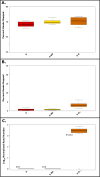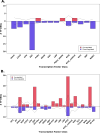Transcriptome profile of pecan scab resistant and susceptible trees from a pecan provenance collection
- PMID: 38355402
- PMCID: PMC10868059
- DOI: 10.1186/s12864-024-10010-0
Transcriptome profile of pecan scab resistant and susceptible trees from a pecan provenance collection
Abstract
Pecan scab is a devastating disease that causes damage to pecan (Carya illinoinensis (Wangenh.) K. Koch) fruit and leaves. The disease is caused by the fungus Venturia effusa (G. Winter) and the main management practice for controlling the disease is by application of fungicides at 2-to-3-week intervals throughout the growing season. Besides disease-related yield loss, application of fungicides can result in considerable cost and increases the likelihood of fungicide resistance developing in the pathogen. Resistant cultivars are available for pecan growers; although, in several cases resistance has been overcome as the pathogen adapts to infect resistant hosts. Despite the importance of host resistance in scab management, there is little information regarding the molecular basis of genetic resistance to pecan scab.The purpose of this study was to elucidate mechanisms of natural pecan scab resistance by analyzing transcripts that are differentially expressed in pecan leaf samples from scab resistant and susceptible trees. The leaf samples were collected from trees in a provenance collection orchard that represents the natural range of pecan in the US and Mexico. Trees in the orchard have been exposed to natural scab infections since planting in 1989, and scab ratings were collected over three seasons. Based on this data, ten susceptible trees and ten resistant trees were selected for analysis. RNA-seq data was collected and analyzed for diseased and non-diseased parts of susceptible trees as well as for resistant trees. A total of 313 genes were found to be differentially expressed when comparing resistant and susceptible trees without disease. For susceptible samples showing scab symptoms, 1,454 genes were identified as differentially expressed compared to non-diseased susceptible samples. Many genes involved in pathogen recognition, defense responses, and signal transduction were up-regulated in diseased samples of susceptible trees, whereas differentially expressed genes in pecan scab resistant samples were generally down-regulated compared to non-diseased susceptible samples.Our results provide the first account of candidate genes involved in resistance/susceptibility to pecan scab under natural conditions in a pecan orchard. This information can be used to aid pecan breeding programs and development of biotechnology-based approaches for generating pecan cultivars with more durable scab resistance.
Keywords: Carya; DEG; Fungal resistance; Pecan; Provenance; RNA-seq; Scab; Venturia.
© 2024. This is a U.S. Government work and not under copyright protection in the US; foreign copyright protection may apply.
Conflict of interest statement
Authors declare that they have no competing interests.
Figures







Similar articles
-
Transcriptome analysis under pecan scab infection reveals the molecular mechanisms of the defense response in pecans.PLoS One. 2024 Nov 21;19(11):e0313878. doi: 10.1371/journal.pone.0313878. eCollection 2024. PLoS One. 2024. PMID: 39570928 Free PMC article.
-
Scab Intensity in Pecan Trees in Relation to Hedge-Pruning Methods.Plant Dis. 2024 Nov;108(11):3381-3392. doi: 10.1094/PDIS-10-23-2247-RE. Epub 2024 Nov 8. Plant Dis. 2024. PMID: 39030659
-
A Comparison of Ground-Based Air-Blast Sprayer and Aircraft Application of Fungicides to Manage Scab in Tall Pecan Trees.Plant Dis. 2020 Jun;104(6):1675-1684. doi: 10.1094/PDIS-11-19-2345-RE. Epub 2020 Apr 22. Plant Dis. 2020. PMID: 32320372
-
Fungicide Resistance in Venturia effusa, Cause of Pecan Scab: Current Status and Practical Implications.Phytopathology. 2021 Feb;111(2):244-252. doi: 10.1094/PHYTO-06-20-0221-RVW. Epub 2021 Jan 11. Phytopathology. 2021. PMID: 33151825 Review.
-
Ascochyta rabiei: A threat to global chickpea production.Mol Plant Pathol. 2022 Sep;23(9):1241-1261. doi: 10.1111/mpp.13235. Epub 2022 Jul 1. Mol Plant Pathol. 2022. PMID: 35778851 Free PMC article. Review.
References
-
- USDA-NASS. Statistics by subject: Pecans, Utilized, In Shell - Production, Measured in $ [Available from: https://www.nass.usda.gov/Statistics_by_Subject/result.php?EB7A7D83-A799....
-
- Grauke LJ, Payne JA, Wood BW. North American pecans: a provenance study. Ann Rep Northern Nut Growers Assoc. 1989;80:124–31.
-
- Rüter B, Hamrick JL, Wood BW. Genetic diversity within provenance and cultivar germplasm collections versus natural populations of pecan (Carya illinoinensis) J Heredity. 1999;90(5):521–8. doi: 10.1093/jhered/90.5.521. - DOI
-
- Bock CH, Alarcon Y, Conner PJ, Young CA, Randall JJ, Pisani C, et al. Foliage and fruit susceptibility of a pecan provenance collection to scab, caused by Venturia effusa. CABI Agric Biosci. 2020;1(1):19. doi: 10.1186/s43170-020-00020-9. - DOI
MeSH terms
Substances
Grants and funding
LinkOut - more resources
Full Text Sources

